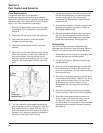
5.2
Section 5
Fuel System and Governor
Fuel System Tests
When the engine starts hard, or turns over but will not start, it is possible that the problem is in the fuel system. To
find out if the fuel system is causing the problem, perform the following tests.
Troubleshooting – Fuel System Related Causes
Test Conclusion
1. Check the following:
a. Make sure the fuel tank contains clean, fresh,
proper fuel.
b. Make sure the vent in fuel tank cap is open.
c. Make sure the fuel valve is open.
d. Make sure vacuum and fuel lines to fuel
pump are secured and in good condition.
2. Check for fuel in the combustion chamber.
a. Disconnect and ground spark plug leads.
b. Close the choke on the carburetor.
c. Crank the engine several revolutions.
d. Remove the spark plug and check for fuel at
the tip.
2. If there is fuel at the tip of the spark plug, fuel is
reaching the combustion chamber.
If there is no fuel at the tip of the spark plug,
check for fuel flow from the fuel tank (Test 3).
3. Check for fuel flow from the tank to the fuel pump.
a. Remove the fuel line from the inlet fitting of
fuel pump.
b. Hold the line below the bottom of the tank.
Open the shut-off valve (if so equipped) and
observe flow.
3. If fuel does flow from the line, check for faulty fuel
pump (Test 4).
If fuel does not flow from the line, check the fuel
tank vent, fuel pickup screen, in-line filter, shut-off
valve, and fuel line. Correct any observed problem
and reconnect the line.
4. Check the operation of fuel pump.
a. Remove the fuel line from the inlet fitting of
carburetor.
b. Crank the engine several times and observe
flow.
4. If fuel does flow from the line, check for faulty
carburetor. (Refer to the "Carburetor" portions of
this section).
If fuel does not flow from the line, check for a
clogged fuel line. If the fuel line is unobstructed,
check for overfilled crankcase and/or oil in pulse
line. If none of the checks reveal the cause of the
problem, replace the pump.


















